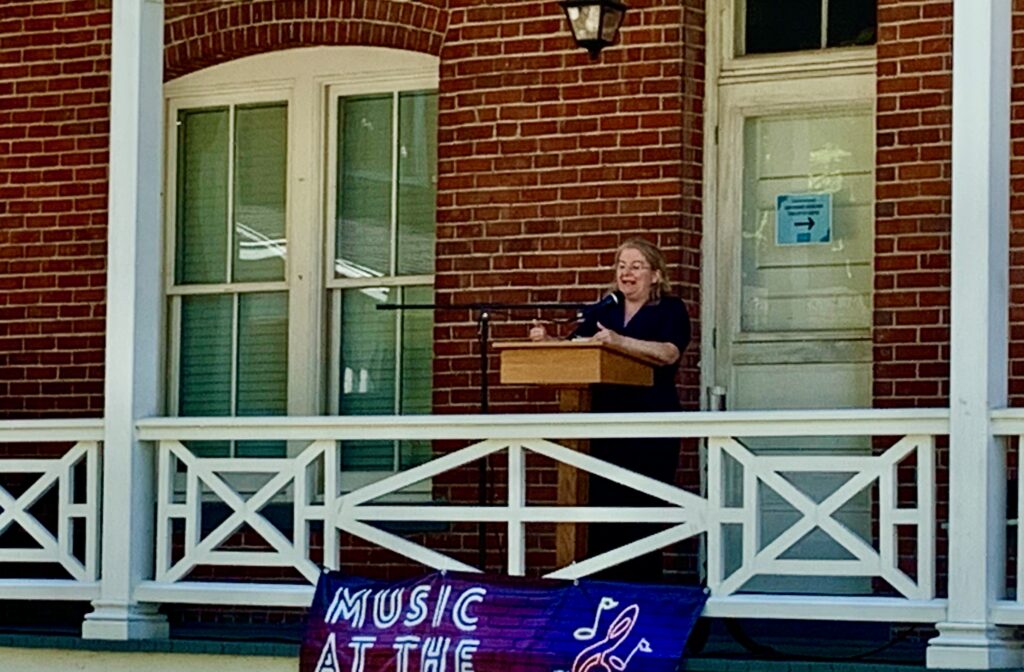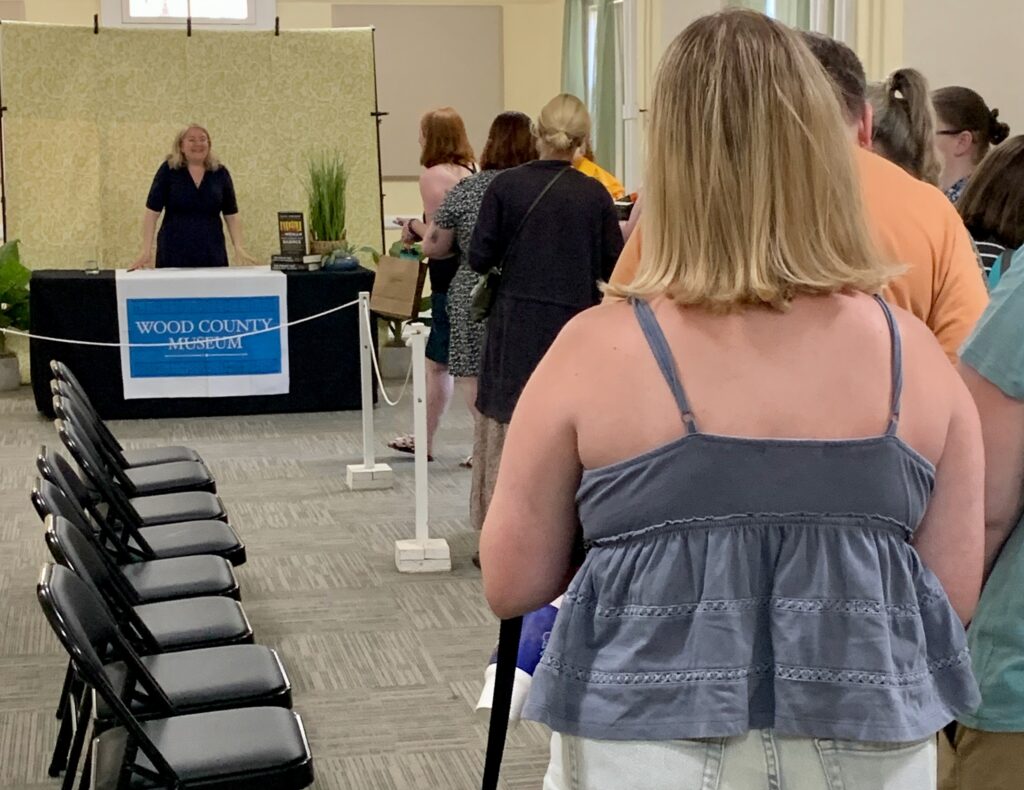By JULIE CARLE
BG Independent News
British author Kate Moore spoke about a woman who was committed to an insane asylum by her husband not because she was insane, but because she dared to disagree with him.
Elizabeth Packard, the 19th century wife and mother who Moore wrote about in her 2021 book “The Women They Could Not Silence,” became a heroine of justice for the rights of the mentally ill and married women.
Speaking on the porch of the Wood County Museum, with the former Lunatic Asylum nearby as a reminder of what once was, Moore unfurled the story of Packard and her fight for justice.
“She became this extraordinary heroine and political campaigner, who succeeds in a way that is not just about saving herself but saving a sisterhood of women,” Moore said. “She was determined no one else would suffer as she had.”
Elizabeth Packard’s story
Elizabeth married Theophilus Packard in 1839; however, the story starts on the cusp of the American Civil War, after 21 years of marriage and six children.
For most of their marriage, Elizabeth wanted nothing more than “to make my husband shine,” she wrote in her diary. The problem was that he didn’t make her shine, Moore said.
While she was vibrant and sociable, Theophilus was gloomy and dull. Though Elizabeth called her marriage “cheerless,” she nevertheless supported her preacher husband, that is until 1848 when the first women’s rights convention was held in Seneca Falls, New York.
The convention unleashed a national conversation about the rights of women. The couple had countless discussions about the topic. “It was Elizabeth, who was naturally blessed with a rare command of language who triumphed in these fights,” Moore said.
Her victories came at a cost. Theophilus didn’t like being outshined by his wife. He counted his growing grievances against her and recorded the slights in his diary. He made it clear he wanted Elizabeth gone.
She continued to speak her mind, asserting it was her right to do so. Eventually, she rejected her husband’s marital authority and his spiritual authority as her preacher, Moore said. Elizabeth went to worship with the Methodists.
The public humiliation was the final straw for Theophilus. He feared she was becoming insane on the subject of women’s rights. With seven simple words, he warned her if she did not conform, “I should put you into the asylum.”

“Of course, he couldn’t send her to a mental hospital just because she disagreed with him, Elizabeth thought,” Moore said. However, she was wrong.
On June 18, 1860, she was forced to go to the Illinois State Hospital in Jacksonville, Illinois, where her husband had her committed.
In the 19th century, women were regularly committed to insane asylums for acts of self-expression, for reading novels, being educated, and for yelling at their husbands.
Even the doctors agreed with the assessment, often diagnosing the women with “moral insanity.” They believed a woman’s sexual organs and her menstrual cycle left her at an increased risk of madness.
Moore said the consensus was women “were supposed to be satisfied with their domestic duties, and they were supposed to stay in their lane.”
Once inside the asylum, Elizabeth saw that most of the women were confined against their will for similar reasons, and they were just as sane as she was.
She believed she would be released soon. “Elizabeth was quick to discover, not only the doctors weren’t on her side, but the law was not on her side, either,” Moore reported.
According to the laws of the era, a husband and wife are one. The wife’s legal civic identity is consumed in the identity of the husband, and the wife has no rights to their property, custody of their children or her own earnings.
The law seems archaic in today’s terms, “but I’d like to remind you that until 1974, a woman couldn’t get a credit card without a man co-signing,” Moore reminded the audience.
Despite being admitted to the insane asylum Elizabeth Packard used the situation to fuel her fire. “I fear no more. I am now free to be true and honest. No opposition can overcome me,” she wrote in her diary.
“It was through this crucible of suffering that Elizabeth found the strength to look inside and see who she was and what she was going to become,” Moore said.
She advocated for herself and hundreds of other sane women who were confined against their will in the Illinois State Hospital.
The reason behind the book
As the author of “The Radium Girls,” a New York Times bestseller and 2017 Goodreads best history and biography award winner, Moore was looking for a new topic for her next book.
[RELATED: BGHS drama club’s ‘Radium Girls’ illuminates timeless issues of greed & exploitation]
“The story for me didn’t start in the 1860s; it started in the fall of 2017 amidst the fire of the electrifying #MeToo Movement,” Moore said.
“It wasn’t the first time women spoke up, but it was the first time women were being listened to and believed,” she added.
She wondered how women had been silenced in the past and realized claiming women are crazy has been an insult and a way of controlling and discrediting women for centuries. She wanted to find a true story of a famed woman in history who was accused of being mad. “And I went looking for her,” Moore said.
But she didn’t discover Elizabeth Packard’s story until she found an article about lunacy in the 19th century in the archives of the University of Wisconsin. “Four pages in, in a single paragraph, I stumbled upon the name of Elizabeth Packard,” she said.
When she Googled her name, Moore knew “she was the one, the woman I was going to write about next.”
Her story was compelling, full of drama, with people coming to her bedroom with axes to carry her to the asylum. There was courtroom drama that involved a landmark legal trial to prove her sanity and gothic horror looking inside asylums of the 19th century.
Above all else, it’s the story of this incredible woman fighting for justice and against injustice that resonates so strongly today, Moore said.
She traveled from England to the U.S. for extensive research, finding Elizabeth’s books and diaries, reading Theophilus’s diaries, records from the Illinois State Hospital, and a hospital named after Andrew McFarland, the doctor who had kept her locked up in the insane asylum for all those years. But nothing was named for Elizabeth Packard.
“The more I learned about the topic and Elizabeth, the more passionate I became about telling her story,” Moore said.
Moore also attended a Sunday service where Theophilus used to preach and was pleased that ironically, the church was led by a female pastor.
“The most powerful part of my research was visiting the site of the former Illinois State Hospital,” Moore said. The huge gates were still there, leaving Moore with a very real sense of crossing over and “losing civilization.”
Peering through the windows of the abandoned buildings was haunting. She saw left-behind furniture, peeling paint on the staircases and “Don’t Open” written in graffiti on the walls.
Old Main, where Elizabeth was housed, was no longer standing, but the windowsills remained where patients etched words and drawings into the sills “just trying to get their messages out to make their mark on the world,” Moore said.

“I think it’s important to open the doors to the past because through them step people like Elizabeth Packard whose spirit helped women fly and soar,” Moore said. “In her writings, she teaches us that in fighting for justice, though it may take time, the truth will always win.”
In the summer of 2023, the Governor of Illinois announced the McFarland Mental Health, named for the former superintendent and doctor at the Illinois State Hospital, would be renamed the Packard Mental Health Center. The new name honors Elizabeth Packard, “who founded the Anti-Insane Asylum Society and pushed multiple states to reform their laws to better recognize the rights of mental health patients,” Gov. JB Pritzker said.
While Elizabeth was in the asylum, she told the doctor, “One day he would see her applauded as the world’s reformer,” Moore said. “It didn’t come in her lifetime, but how wonderful that her prediction came true.”
Elizabeth Packard “is a historically significant heroine. But make no mistake, even though this is a history book, the issues at its core could not be more relevant,” Moore said.





